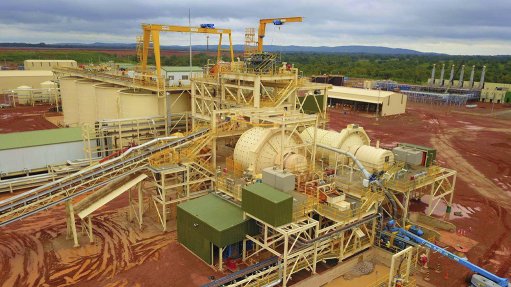
Name: Wahgnion gold operations (WGO).
Location: The mine is located in Léraba province, in south-west Burkina Faso.
Mine Owner/s: Teranga Gold Corporation owns 90% of the property and the Burkina Faso government 10%.
Brief History: Most of the current WGO area was held by Western Mining Corporation (WMC) from 1996 to 1999.
First pass wide-spaced vertical rotary air blast (RAB) drilling by WMC encountered significant mineralisation at the Nogbele and Fourkoura deposits. Resolute (West Africa) and Sanembaore held the property from 1999 to 2005. Resolute completed geological mapping, soil sampling, RAB, and reverse circulation (RC) drilling, while Sanembaore completed geological mapping and rock-chip sampling.
Sanembaore, in joint venture the property with Gryphon Minerals, developed the property between 2005 and 2007. Gryphon acquired Sanembaore’s interest in the property in 2007, and initiated a comprehensive exploration programme comprising geological mapping at various scales, remote sensing, soil and stream sediment sampling, trenching, airborne geophysical surveying, ground geophysical surveying and auger, air core, RAB, RC and diamond drilling on several targets.
From 2011 to 2015, Gryphon completed mineral resource estimates and resource updates on the Nogbele, Fourkoura and Samavogo zones. In 2013, Gryphon completed a feasibility study based on an openpit mining scenario and a two-million-tonne-a-year carbon-in-leach (CIL) processing plant. An updated feasibility study examining the potential for reduced capital through the construction of a two-million-tonne-a-year heap-leach processing option was completed in 2014.
On October 12, 2016, Teranga completed its acquisition of Gryphon.
WGO produced its first gold in September 2019.
Brief Description: WGO comprises five main regions – Nogbele North and Nangolo, Nogbele South, Fourkoura, Stinger and Samavogo. Multiple deposits feed into a central mill and owner-operated truck-and-shovel openpit mining operations.
WGO has a 13-year life-of-mine.
Primary Metals: Gold.
Secondary Metals: None stated.
Geology/Mineralisation: The WGO is located within the Paleoproterozoic Birimian Senoufo belt. The Senoufo belt trends north‐north-east and comprises mainly basaltic and andesitic volcanic rocks, lesser sedimentary rocks and numerous gabbroic to granitic subvolcanic plutons.
Mineralisation at the property is structurally controlled and is widely associated with hematite, iron carbonate, sericite, pyrite and, locally, with albitic alteration. Higher gold grades are commonly associated with stylolitic laminated quartz veins or pyrite veinlets. Coarse-grained gold is found in fractures within pyrite veins or in quartz‐carbonate vein selvages. Mineralisation is predominantly of a lode‐style gold type, associated with discrete structures. This is interpreted to have formed from the same mineralising system, with variations in style reflecting the difference in local lithological and structural settings.
Reserves: Total proven and probable reserves as at May 31, 2018, were estimated at 31.07-million tonnes grading 1.61 g/t gold.
Resources: Total measured and indicated resources as at May 31, 2018, were estimated at 50.5-million tonnes grading 1.51 g/t gold. Inferred resources were estimated at 5.25-million tonnes grading 1.41 g/t gold.
Mining Method: Conventional openpit, using drill-and-blast.
Major Infrastructure and Equipment: WGO comprises multiple openpits. Material movement is undertaken by hydraulic excavators, haul trucks and a fleet of support and ancillary equipment, including track and wheel dozers and water trucks.
Major mine infrastructure consists of a variety of roads, including dedicated mine haul roads, a main access road and general access roads, as well as minor-use roads and tracks.
The process plant design is based on a conventional CIL gold process flowsheet, consisting of primary crushing, semiautogenous grinding and ball milling with a pebble crusher, CIL gold extraction, elution, electrowinning and gold smelting to produce doré on site. Throughput is designed to range between 2.2-million tonnes a year and 2.5-million tonnes a year, depending on the blend of soft and hard ore.
Tailings will be stored in a conventional paddock-style tailings storage facility (TSF), located east of the processing plant.
Prospects: Starting in 2020/21, Teranga plans to embark on a multiyear exploration and drilling programme, which will focus on highly prospective exploration targets within trucking distance of the plant to further optimise the mine plan and extend Wahgnion’s mine life. The current reserve estimate and mine plan include only the four initial deposits on the mine licence.
Contact Details:
Teranga Gold Corporation
Tel +1 416 594 0000
Email investor@terangagold.com
Website https://www.terangagold.com